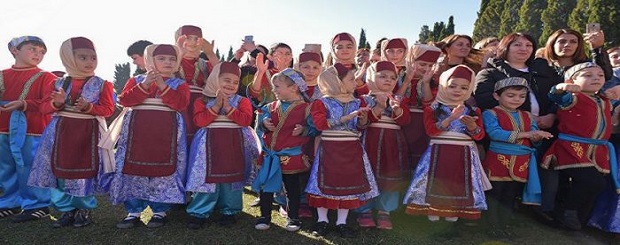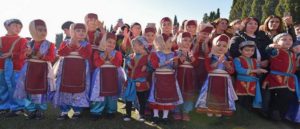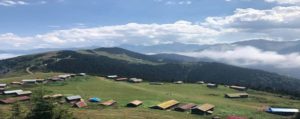
The Hamshen Armenian Dialect And Hamshen Grammar – The Hamshen Armenian Dialect And Hamshen Grammar
January 17, 2020 — Culture, News:
Finally came the moment for us to publish not lamentable but joyful news about Hamshen and Hamshen Armenians.
For the first time, the Hamshenis of Turkey had the opportunity to learn their native language at a new, completely different level. The textbook “Hamşetsnak Lizu Kidanutun” (“The grammar of the Hamshen language”) authored by intellectual and human rights activist Hurie Shagin is a bold and important step in the history of the Hamshen dialect – a step that, although delayed, was by no means belated.
Despite pressure in Turkey, thanks to the courage of our compatriots, Hamshenis, their identity, culture, and language have been preserved and still exist. However, we should note that the Armenian dialect of Hamshenis has survived to this day via the tales of grandmothers from Hamshen valleys, the songs of Hamshen shepherds, the loud laughter of women gathering tea, and the jokes of children in the wooded villages of Artvin and Khopa who would gather in the winter evening by the stove on which chestnuts and nuts were being roasted.
While we are reading sad reports that UNESCO has included the Hamshen language in the list of endangered languages, a bold woman named Hurie Shagin has studied, written, and compiled the first Hamshen-language grammar.
Horizon correspondent Sofia Hakobyan: “Ms. Shagin, you are one of the few representatives of the Hamshen intellectual circle who never questioned that the Hamshenis are Armenians, never avoided open language, and never paid attention either to the pressure of the nationalists, or the prevalence of the Hamshen dialect, or the quite discouraging reports of its condition. Being from an ordinary Hamshen family, how did you decide to devote yourself to this difficult task? When did you get a clear idea of your identity?”
“It all started back in the years of my childhood with the stories of my grandfather. My grandfather has always said that we had been Islamized by the power of the sword.
The road of our pastures ran along the harvests of Artvin. Whenever we walked there, my grandfather pointed to the rocks and said: ‘Armenians were cast down from here.’
He told other things as well. The Armenians said: ‘We could calmly speak our language only in the toilet.’ Grandfather told all this in the Hamshen dialect. And because I was immersed in the revolutionary movement since the age of 13, I became part of the struggle against the oppression of peoples. This allowed me to better understand both the history of Hamshen Armenians and the Armenian Genocide.”
“How was the idea of a book project born?”
“This project has actually existed for a long time. Back in 2014, after completing my book “How the policy of assimilation destroys languages”, which is mainly about Hamshen Armenians and their history, I decided to write this book as well.
In the first book, I argue that the so-called ‘Hamshen language’ is one of the dialects of the Armenian language. I make a comparison between the Eastern Armenian and Western Armenian languages and the Hamshen dialect.
This book, on the other hand, is completely devoted to grammar.
Two things gave me the courage to write this book – the first was the good command of our dialect and the second was a handbook for studying the Armenian language published by the Armenian Patriarchate of Constantinople.
After reading it, I became confident that I would be able to create a work on linguistics. I used much of this book in my work. Since the Hamshen language is a dialect of the Western Armenian language, I was able to use many examples from there, but most of my book is concentrated on the dialect itself.”
“Were there other Armenians who supported you during this period?”
“I owe the publication of this book to Harutyun Cherma. I met him in 2011 – he taught me the Armenian alphabet and the classic Western Armenian language. It was he who gave me the Patriarchate’s book. I remember that that year, in the cold winter, we studied at the cafe ‘Ormanchi tash-fyryn.’ Had we not done this, then all this would not have continued.”
“You mentioned that you consider the Hamshen language a Western Armenian dialect. There are Hamshen intellectuals who, for example, consider it a mixture of Eastern Armenian and Western Armenian. At the same time, some historical sources note that Hamshenis had emigrated from Kotayk and Aragatsotn regions of Eastern Armenia.”

“In my first book, I found and especially noted the Eastern Armenian traces of the Hamshen dialect. Nonetheless, the Hamshen dialect belongs to the “-kə” group.
Throughout my analysis of the Hamshen dialect, what I could not find in Eastern Armenian was found in Western Armenian and vice versa. In fact, I believe that the Hamshen dialect is a classical Armenian language that underlies both Western Armenian and Eastern Armenian. And the Islamization of Hamshenis in the 1700s which cut off local Armenians from the Armenian-speaking education system made it a dialect.
The Armenian intelligentsia of Polis (Constantinople) also went beyond the framework of the classical Armenian language, and although the Church was against it at the time, modern Western Armenian appeared.
My entire work was supervised by Armenian teachers Maral Ustapal and Aras Sarychopan, and after completion, a very beautiful editorial was written by Sevan Nshanyan.”
“The Laz people, neighbors of the Hamshenis, have long resolved a similar issue by presenting the first official textbook of the Laz language. In this regard, your book is the first for the Hamshen dialect. What do you think, what the Laz people had all this time that we didn’t?”
“I believe that this is due to our internal differences. The debate about whether we, in the end, are Armenians or not ‘locks’ us from the inside. Among the peoples of the Ottoman Empire living on the Black Sea coast, Hamshenis were the latest to convert to Islam. Even now, we are the only group in this region that is still fighting and resisting.”
“The same argument became an artificial obstacle not only in the internal relations of the Hamshenis but also in their external relations with other Armenians. Some people are still debating whether a Muslim can be called an Armenian or not. Don’t you think that this is a waste of time and energy which prevents you from focusing on truly important and relevant issues?
“That is precisely why I decided to approach the issue in terms of language – language is the people themselves. I believe that these taboos have already begun to disappear.”
“What do you think contributed to such progress?”
“Firstly, the scientific research that, thanks to our courage, is still carried out has at some point begun to yield results. The interaction and experience of the Armenians who after the collapse of the USSR came from Armenia to Khopa and from Khopa to Armenia were also highly influential. Over the past 10 years, the Internet has also had a significant impact.”
“When people talk about nationalism in Turkey, many are the first to point to Trabzon, as well as the original territories of Hamshen, Rize. This is probably one of the most painful moments in the history of Hamshen Armenians. The Hamshen youth from Khopa often notes that they are very different in thinking and way of life from the Hamshenis from Rize.”
“We cannot observe everyone through the same prism. There are many Hamshenis from Rize who think like us. Since the policy of assimilation and mass killings has begun precisely in the territory of Rize, they have forgotten their native language before others. They have preserved only 500 words, most of which are toponyms.
One of my friends who argued with me and insisted that the Hamshenis were Turks congratulated me three days ago on the publication of my book. That is why we write, work, and regularly debate with them.”
“UNESCO periodically warns that the Hamshen dialect is one of the most endangered languages in Turkey. However, despite this, you have published a grammar textbook and therefore are among those people who really believe that we can change the situation if desired.”
“I believe that this language will live forever. The chronology provided by UNESCO is rather controversial.
Now, the Turkish authorities recognize the right of languages existing in Turkey to be represented as optional courses in the secondary educational system. And UNESCO makes such a statement right now rather than when the languages of all minorities were banned in Turkey.
I am a revolutionary, I do not trust imperialist structures. In the end, UNESCO’s statement is also political.
I submitted a project to the Ministry of Education on the inclusion of the Hamshen dialect of the Armenian language in the secondary school curriculum as a selective subject and presented a 60-page program. Now, the process is underway, and I think that everything will become clear in the next two months.”
February 11, 2019
Source: horizonweekly.ca
allinnet.info/news/the-hamshen-armenian-dialect/?

